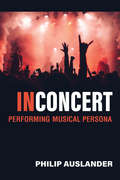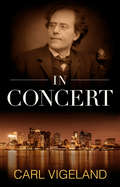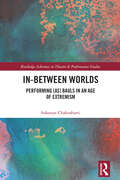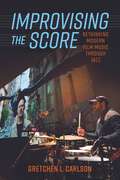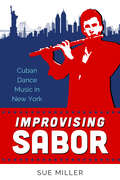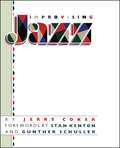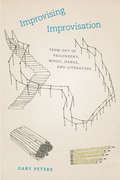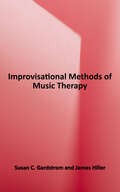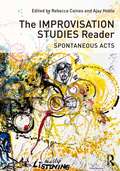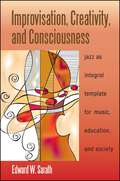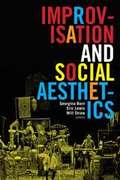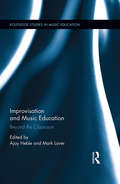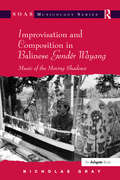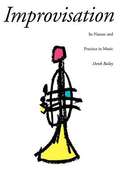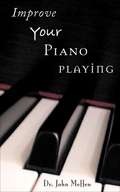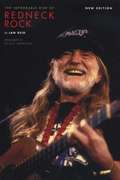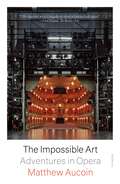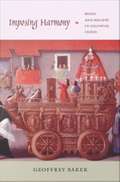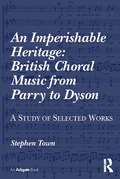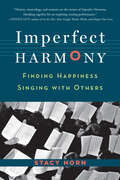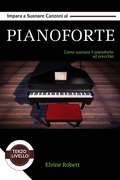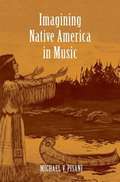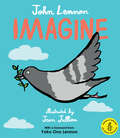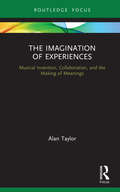- Table View
- List View
In Concert: Performing Musical Persona
by Philip AuslanderThe conventional way of understanding what musicians do as performers is to treat them as producers of sound; some even argue that it is unnecessary to see musicians in performance as long as one can hear them. But musical performance, counters Philip Auslander, is also a social interaction between musicians and their audiences, appealing as much to the eye as to the ear. In Concert: Performing Musical Persona he addresses not only the visual means by which musicians engage their audiences through costume and physical gesture, but also spectacular aspects of performance such as light shows. Although musicians do not usually enact fictional characters on stage, they nevertheless present themselves to audiences in ways specific to the performance situation. Auslander’s term to denote the musician’s presence before the audience is musical persona. While presence of a musical persona may be most obvious within rock and pop music, the book’s analysis extends to classical music, jazz, blues, country, electronic music, laptop performance, and music made with experimental digital interfaces. The eclectic group of performers discussed include the Beatles, Miles Davis, Keith Urban, Lady Gaga, Nicki Minaj, Frank Zappa, B. B. King, Jefferson Airplane, Virgil Fox, Keith Jarrett, Glenn Gould, and Laurie Anderson.
In Concert
by Carl A. VigelandAn intimate, moving, dramatic story about the musicians in a great orchestra who make music come alive in performance and recording. The musicians here are members of the fabled Boston Symphony Orchestra, led by conductor Seiji Ozawa, during a season highlighted by Mahler's Second Symphony, The Resurrection.
In-Between Worlds: Performing [as] Bauls in an Age of Extremism (Routledge Advances in Theatre & Performance Studies)
by Sukanya ChakrabartiThis book examines the performance of Bauls ‘folk’ performers from Bengal, in the context of a rapidly globalizing Indian economy and against the backdrop of extreme nationalistic discourses. Recognizing their scope beyond the musical and cultural realm, Sukanya Chakrabarti engages in discussing the subversive and transformational potency of Bauls and their performances. In-Between Worlds argues that the Bauls through their musical, spiritual, and cultural performances offer ‘joy’ and ‘spirituality,’ thus making space for what Dr. Ambedkar in his famous 1942 speech had identified as ‘reclamation of human personality’. Chakrabarti destabilizes the category of ‘folk’ as a fixed classification or an origin point, and fractures homogeneous historical representations of the Baul as a ‘folk’ performer and a wandering mendicant exposing the complex heterogeneity that characterizes this group. Establishing ‘folk-ness’ as a performance category, and ‘folk festivals’ as sites of performing ‘folk-ness,’ contributing to a heritage industry that thrives on imagined and recreated nostalgia, Chakrabarti examines different sites that produce varied performative identities of Bauls, probing the limits of such categories while simultaneously advocating for polyvocality and multifocality. While this project has grounded itself firmly in performance studies, it has borrowed extensively from fields of postcolonial studies and subaltern histories, literature, ethnography and ethnomusicology, and cosmopolitan studies.
Improvising the Score: Rethinking Modern Film Music through Jazz
by Gretchen L. Carlson2023 Jazz Journalists Association (JJA) Jazz Awards for Books of the Year—Honorable Mention RecipientOn December 4, 1957, Miles Davis revolutionized film soundtrack production, improvising the score for Louis Malle’s Ascenseur pour l’échafaud. A cinematic harbinger of the French New Wave, Ascenseur challenged mainstream filmmaking conventions, emphasizing experimentation and creative collaboration. It was in this environment during the late 1950s to 1960s, a brief “golden age” for jazz in film, that many independent filmmakers valued improvisational techniques, featuring soundtracks from such seminal figures as John Lewis, Thelonious Monk, and Duke Ellington. But what of jazz in film today? Improvising the Score: Rethinking Modern Film Music through Jazz provides an original, vivid investigation of innovative collaborations between renowned contemporary jazz artists and prominent independent filmmakers. The book explores how these integrative jazz-film productions challenge us to rethink the possibilities of cinematic music production. In-depth case studies include collaborations between Terence Blanchard and Spike Lee (Malcolm X, When the Levees Broke), Dick Hyman and Woody Allen (Hannah and Her Sisters), Antonio Sánchez and Alejandro González Iñárritu (Birdman), and Mark Isham and Alan Rudolph (Afterglow). The first book of its kind, this study examines jazz artists’ work in film from a sociological perspective, offering rich, behind-the-scenes analyses of their unique collaborative relationships with filmmakers. It investigates how jazz artists negotiate their own “creative labor,” examining the tensions between improvisation and the conventionally highly regulated structures, hierarchies, and expectations of filmmaking. Grounded in personal interviews and detailed film production analysis, Improvising the Score illustrates the dynamic possibilities of integrative artistic collaborations between jazz, film, and other contemporary media, exemplifying its ripeness for shaping and invigorating twenty-first-century arts, media, and culture.
Improvising Sabor: Cuban Dance Music in New York
by Sue MillerImprovising Sabor: Cuban Dance Music in New York begins in 1960s New York and examines in rich detail the playing styles and international influence of important figures in US Latin music. Such innovators as José Fajardo, Johnny Pacheco, George Castro, and Eddy Zervigón dazzled the Palladium ballroom and other Latin music venues in those crucible years. Author Sue Miller focuses on the Cuban flute style in light of its transformations in the US after the 1959 revolution and within the vibrant context of 1960s New York. While much about Latin jazz and salsa has been written, this book focuses on the relatively unexplored New York charangas that were performing during the chachachá and pachanga craze of the early sixties. Indeed, many accounts cut straight from the 1950s and the mambo to the bugalú’s development in the late 1960s with little mention of the chachachá and pachanga’s popularity in the mid-twentieth century. Improvising Sabor addresses not only this lost and ignored history, but contends with issues of race, class, and identity while evaluating differences in style between players from prerevolution Cuban charangas and those of 1960s New York. Through comprehensive explorations and transcriptions of numerous musical examples as well as interviews with and commentary from Latin musicians, Improvising Sabor highlights a specific sabor that is rooted in both Cuban dance music forms and the rich performance culture of Latin New York. The distinctive styles generated by these musicians sparked compelling points of departure and influence.
Improvising Jazz
by Jerry CokerThis work offers useful information on how jazz music can be improvised.
Improvising Improvisation: From Out of Philosophy, Music, Dance, and Literature
by Gary PetersThere is an ever-increasing number of books on improvisation, ones that richly recount experiences in the heat of the creative moment, theorize on the essence of improvisation, and offer convincing arguments for improvisation’s impact across a wide range of human activity. This book is nothing like that. In a provocative and at times moving experiment, Gary Peters takes a different approach, turning the philosophy of improvisation upside-down and inside-out. Guided by Kant, Hegel, Heidegger, and especially Deleuze—and exploring a range of artists from Hendrix to Borges—Peters illuminates new fundamentals about what, as an experience, improvisation truly is. As he shows, improvisation isn’t so much a genre, idiom, style, or technique—it’s a predicament we are thrown into, one we find ourselves in. The predicament, he shows, is a complex entwinement of choice and decision. The performativity of choice during improvisation may happen “in the moment,” but it is already determined by an a priori mode of decision. In this way, improvisation happens both within and around the actual moment, negotiating a simultaneous past, present, and future. Examining these and other often ignored dimensions of spontaneous creativity, Peters proposes a consistently challenging and rigorously argued new perspective on improvisation across an extraordinary range of disciplines.
Improvisational Methods of Music Therapy
by Susan C. Gardstrom James HillerImprovisational Methods of Music Therapy is the second in a series of textbooks addressing each of the four music therapy methods employed in a variety of clinical contexts. Students and professionals alike will gain foundational knowledge about Clinical Music Improvisation (CMI) and its many variations as pertinent to individual, dyadic, and group improvisation. <p><p> This book is specifically intended as a general roadmap for the design and implementation of therapeutically relevant, effective, and individualized improvisation experiences applicable to a wide range of clinical profiles and interpersonal and cultural contexts. As such, Improvisational Methods of Music Therapy addresses prerequisites, risks, contraindications, inherent affordances, and challenges related to CMI, with overarching considerations and procedural steps for Instrumental, Vocal, and Body Improvisation. Attention is given to the use of CMI toward both client achievement of predetermined and measurable therapeutic objectives (i.e., outcome-oriented practice) and client identification and exploration of needs as they manifest in the musicing process (i.e., experience-oriented practice). Hypothetical case illustrations and summaries of actual clinical cases highlight particular CMI variations and procedures.
The Improvisation Studies Reader: Spontaneous Acts
by Ajay Heble Rebecca CainesImprovisation is a performance practice that animates and activates diverse energies of inspiration, critique, and invention. In recent years it has coalesced into an exciting and innovative new field of interdisciplinary scholarly inquiry, becoming a cornerstone of both practical and theoretical approaches to performance. The Improvisation Studies Reader draws together the works of key artists and thinkers from a range of disciplines, including theatre, music, literature, film, and dance. Divided by keywords into eight sections, this book bridges the gaps between these fields. The book includes case studies, exercises, graphic scores and poems in order to produce a teaching and research resource that identifies central themes in improvisation studies. The sections include: Listening Trust/Risk Flow Dissonance Responsibility Liveness Surprise Hope Each section of the Reader is introduced by a newly commissioned think piece by a key figure in the field, which opens up research questions reflecting on the keyword in question. By placing key theoretical and classic texts in conversation with cutting-edge research and artists’ statements, this book answers the urgent questions facing improvising artists and theorists in the mediatized Twenty-First Century.
Improvisation, Creativity, and Consciousness: Jazz as Integral Template for Music, Education, and Society (SUNY series in Integral Theory)
by Edward W. SarathJazz, America's original art form, can be a catalyst for creative and spiritual development. With its unique emphasis on improvisation, jazz offers new paradigms for educational and societal change. In this provocative book, musician and educator Edward W. Sarath illuminates how jazz offers a continuum for transformation. Inspired by the long legacy of jazz innovators who have used meditation and related practices to bring the transcendent into their lives and work, Sarath sees a coming shift in consciousness, one essential to positive change. Both theoretical and practical, the book uses the emergent worldview known as Integral Theory to discuss the consciousness at the heart of jazz and the new models and perspectives it offers. On a more personal level, the author provides examples of his own involvement in educational reform. His design of the first curriculum at a mainstream educational institution to incorporate a significant meditation and consciousness studies component grounds a radical new vision.
Improvisation and Social Aesthetics
by Eric Lewis Georgina Born Will StrawAddressing a wide range of improvised art and music forms—from jazz and cinema to dance and literature—this volume's contributors locate improvisation as a key site of mediation between the social and the aesthetic. As a catalyst for social experiment and political practice, improvisation aids in the creation, contestation, and codification of social realities and identities. Among other topics, the contributors discuss the social aesthetics of the Association for the Advancement of Creative Musicians, the Feminist Improvising Group, and contemporary Malian music, as well as the virtual sociality of interactive computer music, the significance of "uncreative" improvisation, responses to French New Wave cinema, and the work of figures ranging from bell hooks and Billy Strayhorn to Kenneth Goldsmith. Across its diverse chapters, Improvisation and Social Aesthetics argues that ensemble improvisation is not inherently egalitarian or emancipatory, but offers a potential site for the cultivation of new forms of social relations. It sets out a new conceptualization of the aesthetic as immanently social and political, proposing a new paradigm of improvisation studies that will have reverberations throughout the humanities.Contributors. Lisa Barg, Georgina Born, David Brackett, Nicholas Cook, Marion Froger, Susan Kozel, Eric Lewis, George E. Lewis, Ingrid Monson, Tracey Nicholls, Winfried Siemerling, Will Straw, Zoë Svendsen, Darren Wershler
Improvisation and Music Education: Beyond the Classroom (Routledge Studies in Music Education)
by Ajay Heble Mark LaverThis book offers compelling new perspectives on the revolutionary potential of improvisation pedagogy. Bringing together contributions from leading musicians, scholars, and teachers from around the world, the volume articulates how improvisation can breathe new life into old curricula; how it can help teachers and students to communicate more effectively; how it can break down damaging ideological boundaries between classrooms and communities; and how it can help students become more thoughtful, engaged, and activist global citizens. In the last two decades, a growing number of music educators, music education researchers, musicologists, cultural theorists, creative practitioners, and ethnomusicologists have suggested that a greater emphasis on improvisation in music performance, history, and theory classes offers enormous potential for pedagogical enrichment. This book will help educators realize that potential by exploring improvisation along a variety of trajectories. Essays offer readers both theoretical explorations of improvisation and music education from a wide array of vantage points, and practical explanations of how the theory can be implemented in real situations in communities and classrooms. It will therefore be of interest to teachers and students in numerous modes of pedagogy and fields of study, as well as students and faculty in the academic fields of music education, jazz studies, ethnomusicology, musicology, cultural studies, and popular culture studies.
Improvisation and Composition in Balinese Gendér Wayang: Music of the Moving Shadows (SOAS Studies in Music Series)
by Nicholas GrayThis book is an examination of the music of the Balinese gendér wayang, the quartet of metallophones - gendér - that accompanies the Balinese shadow puppet play - wayang kulit. The book focuses on processes of musical variation, the main means of creating new music in this genre, and the implications of these processes for the social and historical study of Balinese music, musical aesthetics, concepts of creativity and compositional methods. Dr Nick Gray tackles a number of core ethnomusicological concerns in a new way, including the relationship between composition and improvisation, and also highlights issues specific to Balinese music, including the importance of flexibility in performance, an aspect that has been largely ignored by scholars. Gray thus breaks new ground both in the study of issues relating to improvisation and composition and in Balinese music studies.
Improvisation: Its Nature And Practice In Music
by Derek BaileyDerek Bailey'sImprovisation, originally published in 1980, and here updated and extended with new interviews and photographs, is the first book to deal with the nature of improvisation in all its forms--Indian music, flamenco, baroque, organ music, rock, jazz, contemporary, and "free" music. By drawing on conversations with some of today's seminal improvisers--including John Zorn, Jerry Garcia, Steve Howe, Steve Lacy, Lionel Salter, Earle Brown, Paco Pe#65533;a, Max Roach, Evan Parker, and Ronnie Scott--Bailey offers a clear-eyed view of the breathtaking spectrum of possibilities inherent in improvisational practice, while underpinning its importance as the basis for all music-making.
Improve Your Piano Playing
by John MeffenFor anyone with basic piano playing skills looking to dramatically improve his or her technique for performances or for personal pleasure, Dr. John Meffen offers simplified and tested techniques explained clearly, concisely, and occasionally humorously. Meffen offers a structured process of practice, making learning a new piece easy. Readers will learn:--Techniques to eradicate recurring mistakes--Workable fingering--Expressive touch--Methods to deal with tricky passages--Proper phrasing and tone production--Pedaling--How to do justice to the composer's work--Correct interpretation of musical scores. In addition, an invaluable chapter on the inner workings of the piano will help musicians of all stages and ages choose the right piano for their needs and abilities.
Improve Your Piano Playing
by John MeffenSure, you play the piano...about as well as you played when your piano teacher, Mrs. Rosenberg, retired in 1979. Now the time has come to take your playing skills to the next level with Improve Your Piano Playing. Techniques are explained clearly so that anyone who already plays for personal pleasure or performance can eliminate recurring mistakes and master the art of workable fingering, expressive touch, phrasing, tone production, and pedaling. Through a structured process of practice, learning new pieces is made simple-the techniques focus on correcting frequent mistakes, dealing with tricky passages, and interpretation. A section on pianos and how they work contains information every musician should know. Mrs. Rosenberg is gone now, but you can still make her proud-with Improve Your Piano Playing.
The Improbable Rise of Redneck Rock: New Edition
by Jan ReidMusical magic hit Austin, Texas, in the early 1970s. At now-legendary venues such as Threadgill's, Vulcan Gas Company, and the Armadillo World Headquarters, a host of country, rock-and-roll, blues, and folk musicians came together and created a sound and a scene that Jan Reid vividly detailed in his 1974 book, The Improbable Rise of Redneck Rock. The breadth of talent still astounds-Willie Nelson, Janis Joplin, Jerry Jeff Walker, Doug Sahm, Delbert McClinton, Michael Martin Murphey, Willis Alan Ramsey, Kinky Friedman, Steve Fromholz, Bobby Bridger, Billy Joe Shaver, Marcia Ball, and Townes Van Zandt. Reid's book even inspired the nationally popular and long-running PBS series Austin City Limits, which focused attention on the trends that fed the music scene-progressive country, country rock, western swing, blues, and bluegrass among them. In this new edition, Jan Reid revitalizes his classic look at the Austin music scene. He has substantially reworked the early chapters to include musicians and musical currents from other parts of Texas that significantly contributed to the delightful convergence of popular cultures in Austin. Four new chapters and an epilogue show how the creative burst of the seventies directly spawned a new generation of talents who carry on the tradition-Lyle Lovett, Stevie Ray Vaughan, The Fabulous Thunderbirds, Robert Earl Keen, Steve Earle, Jimmy LaFave, Kelly Willis, Joe Ely, Bruce and Charlie Robison, and The Dixie Chicks.
The Impossible Art: Adventures in Opera
by Matthew AucoinA user's guide to opera—Matthew Aucoin, "the most promising operatic talent in a generation" (The New York Times Magazine), describes the creation of his groundbreaking new work, Eurydice, and shares his reflections on the past, present, and future of operaFrom its beginning, opera has been an impossible art. Its first practitioners, in seventeenth-century Florence, set themselves the unreachable goal of reproducing the wonders of ancient Greek drama, which no one can be sure was sung in the first place. Opera’s greatest artists have striven to fuse multiple art forms—music, drama, poetry, dance—into a unified synesthetic experience. The composer Matthew Aucoin, a rising star of the opera world, posits that it is this impossibility that gives opera its exceptional power and serves as its lifeblood. The virtuosity required of its performers, the bizarre and often spectacular nature of its stage productions, the creation of a whole world whose basic fabric is music—opera assumes its true form when it pursues impossible goals.The Impossible Art is a passionate defense of what is best about opera, a love letter to the form, written in the midst of a global pandemic during which operatic performance was (literally) impossible. Aucoin writes of the rare works—ranging from classics by Mozart and Verdi to contemporary offerings of Thomas Adès and Chaya Czernowin—that capture something essential about human experience. He illuminates the symbiotic relationship between composers and librettists, between opera’s greatest figures and those of literature. Aucoin also tells the story of his new opera, Eurydice, from its inception to its production on the Metropolitan Opera’s iconic stage. The Impossible Art opens the theater door and invites the reader into this extraordinary world.
Imposing Harmony: Music and Society in Colonial Cuzco
by Geoffrey BakerImposing Harmony is a groundbreaking analysis of the role of music and musicians in the social and political life of colonial Cuzco. Challenging musicology's cathedral-centered approach to the history of music in colonial Latin America, Geoffrey Baker demonstrates that rather than being dominated by the cathedral, Cuzco's musical culture was remarkably decentralized. He shows that institutions such as parish churches and monasteries employed indigenous professional musicians, rivaling Cuzco Cathedral in the scale and frequency of the musical performances they staged. Building on recent scholarship by social historians and urban musicologists and drawing on extensive archival research, Baker highlights European music as a significant vehicle for reproducing and contesting power relations in Cuzco. He examines how Andean communities embraced European music, creating an extraordinary cultural florescence, at the same time that Spanish missionaries used the music as a mechanism of colonialization and control. Uncovering a musical life of considerable and unexpected richness throughout the diocese of Cuzco, Baker describes a musical culture sustained by both Hispanic institutional patrons and the upper strata of indigenous society. Mastery of European music enabled elite Andeans to consolidate their position within the colonial social hierarchy. Indigenous professional musicians distinguished themselves by fulfilling important functions in colonial society, acting as educators, religious leaders, and mediators between the Catholic Church and indigenous communities.
An Imperishable Heritage: A Study of Selected Works
by Stephen TownThe rehabilitation of British music began with Hubert Parry and Charles Villiers Stanford. Ralph Vaughan Williams assisted in its emancipation from continental models, while Gerald Finzi, Edmund Rubbra and George Dyson flourished in its independence. Stephen Town's survey of Choral Music of the English Musical Renaissance is rooted in close examination of selected works from these composers. Town collates the substantial secondary literature on these composers, and brings to bear his own study of the autograph manuscripts. The latter form an unparalleled record of compositional process and shed new light on the compositions as they have come down to us in their published and recorded form. This close study of the sources allows Town to identify for the first time instances of similarity and imitation, continuities and connections between the works.
Imperfect Harmony: Finding Happiness Singing with Others
by Stacy HornFor Stacy Horn, regardless of what is going on in the world or her life, singing in an amateur choir—the Choral Society of Grace Church in New York—never fails to take her to a place where hope reigns and everything good is possible. She’s not particularly religious, and her voice is not exceptional (so she says), but like the 32.5 million other chorus members throughout this country, singing makes her happy. Horn brings us along as she sings some of the greatest music humanity has ever produced, delves into the dramatic stories of conductors and composers, unearths the fascinating history of group singing, and explores remarkable discoveries from the new science of singing, including all the unexpected health benefits. Imperfect Harmony is the story of one woman who has found joy and strength in the weekly ritual of singing and in the irresistible power of song.
Impara a suonare canzoni al pianoforte: Come suonare il pianoforte ad orecchio
by Elvine RobertEhilà! Sei stanco di non saper suonare il pianoforte come hai sempre sognato? Sei esperto di teoria pianistica, ma non sai ancora come applicare praticamente questa conoscenza al tuo pianoforte? Allora questo libro è per te! in questo libro, Impara a suonare canzoni al pianoforte, vedremo: Alterazioni degli accordi. Come le melodie sono armonizzate usando accordi sia semplici che avanzati. Come riprodurre vari brani ad orecchio. Le canzoni che vedremo includono: Amazing Grace Pass me not O come, let us adore Him (Adeste fideles) Silent Night (Astro del ciel) Don't know why e molte altre! Questo libro segnerebbe la fine della serie "The Gateway to Perfection" NON PERDERE QUESTA GRANDE OPPORTUNITÀ E OTTIENI LA TUA COPIA ORA SU COME SUONARE IL PIANOFORTE! Per ottenere una copia, scorrere verso l'alto e fare clic sul pulsante ACQUISTA o AGGIUNGI AL CARRELLO.
Imagining Native America in Music
by Michael V. PisaniThis book offers a comprehensive look at musical representations of native America from the precolonial past through the American West and up to the present. The discussion covers a wide range of topics, from the ballets of Lully in the court of Louis XIV to popular ballads of the nineteenth century; from eighteenth-century British-American theater to the musical theater of Irving Berlin; from chamber music by Dvoˆrák to film music for Apaches in Hollywood Westerns. Michael Pisani demonstrates how European colonists and their descendants were fascinated by the idea of race and ethnicity in music, and he examines how music contributed to the complex process of cultural mediation. Pisani reveals how certain themes and metaphors changed over the centuries and shows how much of this "Indian music," which was and continues to be largely imagined, alternately idealized and vilified the peoples of native America.
Imagine: Level 5 - Intermediate Showcase Solos Pop Sheet (Original Sheet Music Edition Ser.)
by John Lennon Jean JullienImagine all the people living life in peace. You may say I'm a dreamer, but I'm not the only one. I hope some day you'll join us, and the world will be as one. Join one little pigeon as she sets out on a journey to spread a message of tolerance around the world. Featuring the lyrics of John Lennon’s iconic song and illustrations by the award-winning artist Jean Jullien, this poignant and timely picture book dares to imagine a world at peace. Imagine will be published in partnership with human rights organization Amnesty International.
The Imagination of Experiences: Musical Invention, Collaboration, and the Making of Meanings
by Alan TaylorAimed at lay, student, and academic readers alike, this book concerns the imagination and, specifically, imagination in music. It opens with a discussion of the invalidity of the idea of the creative genius and the connected view that ideas originate just in the individual mind. An alternative view of the imaginative process is then presented, that ideas spring from a subconscious dialogue activated by engagement in the world around. Ideas are therefore never just of our own making. This view is supported by evidence from many studies and corresponds with descriptions by artists of their experience of imagining. The third subject is how imaginations can be shared when musicians work with other artists, and the way the constraints imposed by trying to share subconscious imagining result in clearly distinct forms of joint working. The final chapter covers the use of the musical imagination in making meanings from music. The evidence is that music does not communicate meanings directly, and so composers or performers cannot be looked to as authorities on its meaning. Instead, music is commonly heard as analogous to human experience, and listeners who perceive such analogies may then imagine their own meanings from the music.
